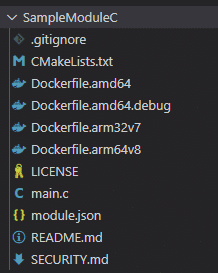
35. 最新の IoT Edge Module 開発環境を試す
はじめに
前回の記事を書く時、久しぶりに、Visual Studio Code + IoT Edge 拡張で新しく IoT Edge Module を作ってみたら、生成された C# コードがかなり変わっていて驚きました。今回は、最新の IoT Edge 拡張で生成したコードをガン見することにします。
おさらい
Visual Studio Code に IoT Edge 拡張をインストールすると、IoT Edge Module を開発できるようになるのは、以前からこの定期購読マガジンでも紹介してきました。この開発環境について、簡単に振り返りを行います。
開発に関する概要は、
Visual Studio Code を使用して Azure IoT Edge モジュールを開発およびデバッグする | Microsoft Learn
に書いてあるので、こちらを参照してもらうとして、ポイントだけ書いておきます。…まてまて、このリンク、Visual Studio Code + IoT Edge 拡張による開発に関するものではないですね。PowerShell や Bash 等のコマンドラインでの開発方法の説明が書いてありました。Visual Studio Code は開発したコードのリモートデバッグで使うという事です。まぁ、この記事も実際の開発では役立つ情報なので、覚えておくとよいでしょう。
で、Visual Studio Code + IoT Edge 拡張のセッティングや、IoT Edge Module の開発については、
Visual Studio Code を使用して Azure IoT Edge モジュールを開発およびデバッグする | Microsoft Learn
こちらの方でした。あれ?字面一緒?それぞれの URL を確認すると、最後の pivots の値が異なります。
Windows PC で Visual Studio Code + IoT Edge 拡張 を使うには、
が、必要です。ってことは、Windows Home でなく、Windows Professional 以上の OS が必要という事ですね。ご注意ください。
Visual Studio Code は、https://visualstudio.microsoft.com/ からインストーラをダウンロード・実行すれば簡単にインストールできます。
IoT Edge 拡張は、Azure IoT Edge - Visual Studio Marketplace から公開されています。インストールは簡単で、

Visual Studio Code の Extension で ”Azure IoT Edge” を検索してインストールを行います。
この拡張ツールでは、C/C++、C#、Node.JS、Python 等、様々なプログラミング言語での開発が可能ですが、それぞれ、
Python - Python - Visual Studio Marketplace
の拡張インストールが必要です。他にも、C# の場合は、.NET Framework SDK、Node.JS の場合は、node.js と npm の、Windows PC へのインストールが必要です。
最新の Visual Studio Code +IoT Edge extension で IoT Edge Module プロジェクトを作ってみる
それでは、2023/2/21 現在の最新の Azure IoT Edge 拡張で、C言語、C#、Node.js、Python の IoT Edge Module プロジェクトを作ってみます。
Azure IoT Edge のバージョンは、1.25.1 です。
C言語
生成されたファイル群は以下の通りです。構成自体は変わっていません。

main.c のコードは、
// Copyright (c) Microsoft. All rights reserved.
// Licensed under the MIT license. See LICENSE file in the project root for full license information.
#include <stdio.h>
#include <stdlib.h>
#include "iothub_module_client_ll.h"
#include "iothub_client_options.h"
#include "iothub_message.h"
#include "azure_c_shared_utility/threadapi.h"
#include "azure_c_shared_utility/crt_abstractions.h"
#include "azure_c_shared_utility/platform.h"
#include "azure_c_shared_utility/shared_util_options.h"
#include "iothubtransportmqtt.h"
#include "iothub.h"
#include "time.h"
typedef struct MESSAGE_INSTANCE_TAG
{
IOTHUB_MESSAGE_HANDLE messageHandle;
size_t messageTrackingId; // For tracking the messages within the user callback.
}
MESSAGE_INSTANCE;
size_t messagesReceivedByInput1Queue = 0;
// SendConfirmationCallback is invoked when the message that was forwarded on from 'InputQueue1Callback'
// pipeline function is confirmed.
static void SendConfirmationCallback(IOTHUB_CLIENT_CONFIRMATION_RESULT result, void* userContextCallback)
{
// The context corresponds to which message# we were at when we sent.
MESSAGE_INSTANCE* messageInstance = (MESSAGE_INSTANCE*)userContextCallback;
printf("Confirmation[%zu] received for message with result = %d\r\n", messageInstance->messageTrackingId, result);
IoTHubMessage_Destroy(messageInstance->messageHandle);
free(messageInstance);
}
// Allocates a context for callback and clones the message
// NOTE: The message MUST be cloned at this stage. InputQueue1Callback's caller always frees the message
// so we need to pass down a new copy.
static MESSAGE_INSTANCE* CreateMessageInstance(IOTHUB_MESSAGE_HANDLE message)
{
MESSAGE_INSTANCE* messageInstance = (MESSAGE_INSTANCE*)malloc(sizeof(MESSAGE_INSTANCE));
if (NULL == messageInstance)
{
printf("Failed allocating 'MESSAGE_INSTANCE' for pipelined message\r\n");
}
else
{
memset(messageInstance, 0, sizeof(*messageInstance));
if ((messageInstance->messageHandle = IoTHubMessage_Clone(message)) == NULL)
{
free(messageInstance);
messageInstance = NULL;
}
else
{
messageInstance->messageTrackingId = messagesReceivedByInput1Queue;
}
}
return messageInstance;
}
static IOTHUBMESSAGE_DISPOSITION_RESULT InputQueue1Callback(IOTHUB_MESSAGE_HANDLE message, void* userContextCallback)
{
IOTHUBMESSAGE_DISPOSITION_RESULT result;
IOTHUB_CLIENT_RESULT clientResult;
IOTHUB_MODULE_CLIENT_LL_HANDLE iotHubModuleClientHandle = (IOTHUB_MODULE_CLIENT_LL_HANDLE)userContextCallback;
unsigned const char* messageBody;
size_t contentSize;
if (IoTHubMessage_GetByteArray(message, &messageBody, &contentSize) != IOTHUB_MESSAGE_OK)
{
messageBody = "<null>";
}
printf("Received Message [%zu]\r\n Data: [%s]\r\n",
messagesReceivedByInput1Queue, messageBody);
// This message should be sent to next stop in the pipeline, namely "output1". What happens at "outpu1" is determined
// by the configuration of the Edge routing table setup.
MESSAGE_INSTANCE *messageInstance = CreateMessageInstance(message);
if (NULL == messageInstance)
{
result = IOTHUBMESSAGE_ABANDONED;
}
else
{
printf("Sending message (%zu) to the next stage in pipeline\n", messagesReceivedByInput1Queue);
clientResult = IoTHubModuleClient_LL_SendEventToOutputAsync(iotHubModuleClientHandle, messageInstance->messageHandle, "output1", SendConfirmationCallback, (void *)messageInstance);
if (clientResult != IOTHUB_CLIENT_OK)
{
IoTHubMessage_Destroy(messageInstance->messageHandle);
free(messageInstance);
printf("IoTHubModuleClient_LL_SendEventToOutputAsync failed on sending msg#=%zu, err=%d\n", messagesReceivedByInput1Queue, clientResult);
result = IOTHUBMESSAGE_ABANDONED;
}
else
{
result = IOTHUBMESSAGE_ACCEPTED;
}
}
messagesReceivedByInput1Queue++;
return result;
}
static IOTHUB_MODULE_CLIENT_LL_HANDLE InitializeConnection()
{
IOTHUB_MODULE_CLIENT_LL_HANDLE iotHubModuleClientHandle;
if (IoTHub_Init() != 0)
{
printf("Failed to initialize the platform.\r\n");
iotHubModuleClientHandle = NULL;
}
else if ((iotHubModuleClientHandle = IoTHubModuleClient_LL_CreateFromEnvironment(MQTT_Protocol)) == NULL)
{
printf("ERROR: IoTHubModuleClient_LL_CreateFromEnvironment failed\r\n");
}
else
{
// Uncomment the following lines to enable verbose logging.
// bool traceOn = true;
// IoTHubModuleClient_LL_SetOption(iotHubModuleClientHandle, OPTION_LOG_TRACE, &trace);
}
return iotHubModuleClientHandle;
}
static void DeInitializeConnection(IOTHUB_MODULE_CLIENT_LL_HANDLE iotHubModuleClientHandle)
{
if (iotHubModuleClientHandle != NULL)
{
IoTHubModuleClient_LL_Destroy(iotHubModuleClientHandle);
}
IoTHub_Deinit();
}
static int SetupCallbacksForModule(IOTHUB_MODULE_CLIENT_LL_HANDLE iotHubModuleClientHandle)
{
int ret;
if (IoTHubModuleClient_LL_SetInputMessageCallback(iotHubModuleClientHandle, "input1", InputQueue1Callback, (void*)iotHubModuleClientHandle) != IOTHUB_CLIENT_OK)
{
printf("ERROR: IoTHubModuleClient_LL_SetInputMessageCallback(\"input1\")..........FAILED!\r\n");
ret = 1;
}
else
{
ret = 0;
}
return ret;
}
void iothub_module()
{
IOTHUB_MODULE_CLIENT_LL_HANDLE iotHubModuleClientHandle;
srand((unsigned int)time(NULL));
if ((iotHubModuleClientHandle = InitializeConnection()) != NULL && SetupCallbacksForModule(iotHubModuleClientHandle) == 0)
{
// The receiver just loops constantly waiting for messages.
printf("Waiting for incoming messages.\r\n");
while (true)
{
IoTHubModuleClient_LL_DoWork(iotHubModuleClientHandle);
ThreadAPI_Sleep(100);
}
}
DeInitializeConnection(iotHubModuleClientHandle);
}
int main(void)
{
iothub_module();
return 0;
}このコードは、以降で紹介する、C#、Node.JS、Python と同等のロジックです。ロゼッタストーン的に見てみるのも面白いでしょう。
次に、CMakeList.txt を見てみます。これは、C/C++ の開発プロジェクトでよく使われる Makefile 自動生成ツールの "cmake”用のファイルです。
cmake_minimum_required(VERSION 2.8.11)
macro(compileAsC99)
if (CMAKE_VERSION VERSION_LESS "3.1")
if (CMAKE_C_COMPILER_ID STREQUAL "GNU")
set (CMAKE_C_FLAGS "--std=c99 ${CMAKE_C_FLAGS}")
set (CMAKE_CXX_FLAGS "--std=c++11 ${CMAKE_CXX_FLAGS}")
endif()
else()
set (CMAKE_C_STANDARD 99)
set (CMAKE_CXX_STANDARD 11)
endif()
endmacro(compileAsC99)
compileAsC99()
set(CMAKE_CXX_FLAGS "${CMAKE_CXX_FLAGS} -DUSE_EDGE_MODULES")
set(CMAKE_C_FLAGS "${CMAKE_C_FLAGS} -DUSE_EDGE_MODULES")
set(AZUREIOT_INC_FOLDER "/usr/include/azureiot" "/usr/include/azureiot/inc")
include_directories(${AZUREIOT_INC_FOLDER})
set(main_c_files
./main.c
)
add_executable(main ${main_c_files})
target_link_libraries(main
iothub_client_mqtt_transport
iothub_client
parson
umqtt
prov_auth_client
hsm_security_client
uhttp
aziotsharedutil
pthread
curl
ssl
crypto
m
uuid
)次は、Dockerfile を見てみます。amd64 向けの、Dockerfile.amd64 を取り上げると、
FROM ubuntu:bionic AS base
RUN apt-get update && \
apt-get install -y --no-install-recommends software-properties-common && \
add-apt-repository -y ppa:aziotsdklinux/ppa-azureiot && \
apt-get update && \
apt-get install -y azure-iot-sdk-c-dev && \
rm -rf /var/lib/apt/lists/*
FROM base AS build-env
RUN apt-get update && \
apt-get install -y --no-install-recommends cmake gcc g++ make && \
rm -rf /var/lib/apt/lists/*
WORKDIR /app
COPY . ./
RUN cmake .
RUN make
FROM base
WORKDIR /app
COPY --from=build-env /app ./
RUN useradd -ms /bin/bash moduleuser
USER moduleuser
CMD ["./main"]Base Image は、ubuntu:bionic なので、Ubuntu 18.04 が使われています。C/C++ 言語の開発環境のインストールと、cmake により Makefile を生成して、make でビルドし、main という実行ファイルが作成されて、その実行ファイルを起動する、といった内容が定義されています。
まぁ、Docker テクノロジーを活用した IoT Edge Module では、C 言語を使っての開発はレアだと思うので、これくらいにしておきます。C言語については、後日また改めて、小規模 HW での IoT Hub 接続と絡めて深~く取り上げる予定です。
C#
C# は結構変わりました。
ここから先は
Azure の最新機能で IoT を改めてやってみる
2022年3月にマイクロソフトの中の人から外の人になった Embedded D. George が、現時点で持っている知識に加えて、頻繁に…
この記事が気に入ったらサポートをしてみませんか?
